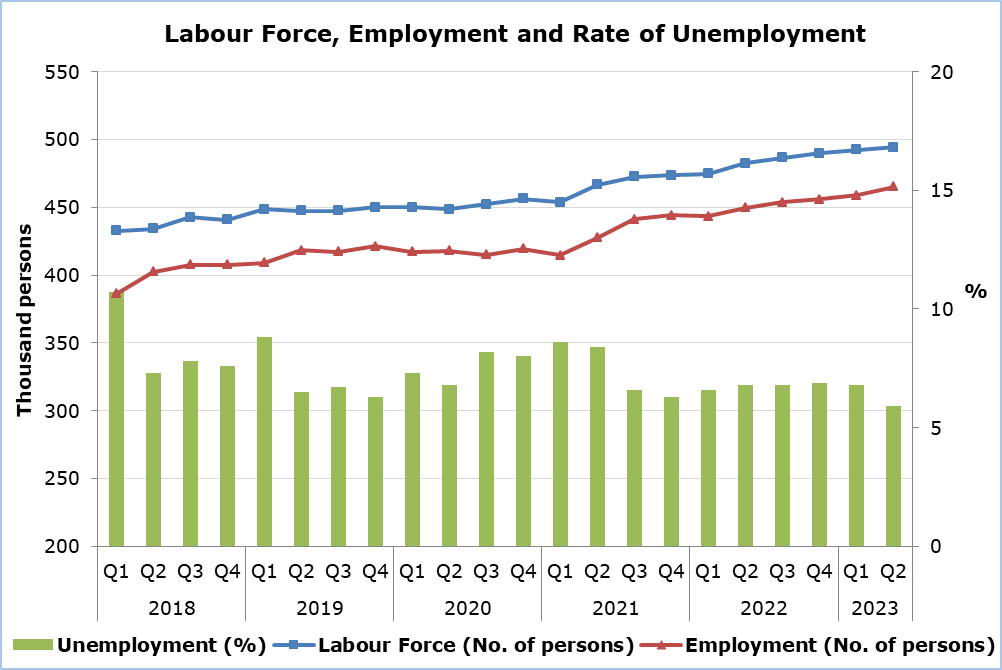Press Releases

06-09-2023 13:14
Labour Force Survey (LFS): 2nd Quarter 2023
Unemployment 5,9%
According to the results of the Labour Force Survey, the labour force in the 2nd quarter of 2023 amounted to 494.246 persons or 65,6% of the population (males 70,6%, females 61,1%) in comparison to 482.385 persons (65,1%) in the corresponding quarter of 2022 (Table 1).
The number of employed persons was 464.878 and the employment rate 61,7% (males 66,3%, females 57,5%) in comparison to 449.482 persons (60,6%) in the corresponding quarter of 2022.
The number of unemployed persons amounted to 29.367 and the unemployment rate to 5,9% of the labour force (males 6,0%, females 5,8%) in comparison to 32.903 persons (6,8%) in the corresponding quarter of 2022.

Employment (Table 2)
For the age group 20-64, the employment rate was 79,2%. The rate for males was 84,0% and for females 74,8%. In the corresponding quarter of 2022 the rate was 78,0% (males 84,2%, females 72,2%). For the age group 55-64 the employment rate was 67,2% in comparison to 65,9% in the corresponding quarter of 2022.
According to the distribution of employment by sector, the biggest percentage of employed persons was in Services (81,3%), followed by Manufacturing (16,6%) and Agriculture (2,1%). For the 2nd quarter of 2022, the corresponding percentages were: Services 80,7%, Manufacturing 16,8% and Agriculture 2,5%.
The share of part-time employment to total employment was 9,0% or 41.671 persons (males 6,9%, females 11,2%). The corresponding rate for the 2nd quarter of 2022 was 10,9% (males 9,0%, females 13,0%).
89,6% or 416.730 of the total employed persons were employees, of which 13,4% (55.714 persons) had a temporary job. In the corresponding quarter of 2022 employees accounted for 89,1% of total employment of which 11,4% had a temporary job.
Unemployment (Table 3)
For young persons aged 15-24 years old, the unemployment rate was 15,6% of the labour force of the same age group (males 18,2%, females 13,0%) in comparison to 17,6% (males 16,3%, females 18,9%) in the corresponding quarter of last year.
As far as the duration of unemployment is concerned, 49,3% of the total unemployed persons searched for a job for a period of less than 6 months, 17,8% for a period of 6-11 months, whereas a percentage of 32,9% were long-term unemployed. The corresponding rates for the 2nd quarter of 2022 were 49,3%, 13,3% and 37,4%.
|
Table 1 |
|
|
||
|
|
Number |
Percentage (%) |
||
|
Q2 2023 |
Q2 2022 |
Q2 2023 |
Q2 2022 |
|
|
|
|
|
|
|
|
Labour Force |
|
|
|
|
|
Total |
494.246 |
482.385 |
65,6 |
65,1 |
|
Males |
254.688 |
252.774 |
70,6 |
71,2 |
|
Females |
239.557 |
229.611 |
61,1 |
59,5 |
|
|
|
|
|
|
|
Employment |
|
|
|
|
|
Total |
464.878 |
449.482 |
61,7 |
60,6 |
|
Males |
239.334 |
237.685 |
66,3 |
66,9 |
|
Females |
225.544 |
211.797 |
57,5 |
54,9 |
|
|
|
|
|
|
|
Unemployment |
|
|
|
|
|
Total |
29.367 |
32.903 |
5,9 |
6,8 |
|
Males |
15.354 |
15.088 |
6,0 |
6,0 |
|
Females |
14.014 |
17.815 |
5,8 |
7,8 |
|
Table2 |
||||||||||||
|
Employment |
Number |
Percentage (%) |
||||||||||
|
Q2 2023 |
Q22022 |
Q22023 |
Q2 2022 |
|||||||||
|
Total |
M |
F |
Total |
M |
F |
Total |
M |
F |
Total |
M |
F |
|
|
Age |
|
|
|
|
|
|
|
|
|
|
|
|
|
15+ |
464.878 |
239.334 |
225.544 |
449.482 |
237.685 |
211.797 |
61,7 |
66,3 |
57,5 |
60,6 |
66,9 |
54,9 |
|
20–64 |
444.673 |
227.057 |
217.616 |
431.244 |
224.731 |
206.515 |
79,2 |
84,0 |
74,8 |
78,0 |
84,2 |
72,2 |
|
55–64 |
73.488 |
40.374 |
33.114 |
70.560 |
40.825 |
29.735 |
67,2 |
74,5 |
59,9 |
65,9 |
76,9 |
55,1 |
|
|
|
|
|
|
|
|
|
|
|
|
|
|
|
Sector |
|
|
|
|
|
|
|
|
|
|
|
|
|
Agriculture |
9.789 |
8.153 |
1.636 |
11.235 |
9.255 |
1.980 |
2,1 |
3,4 |
0,7 |
2,5 |
3,9 |
0,9 |
|
Industry |
76.943 |
60.020 |
16.923 |
75.737 |
59.555 |
16.181 |
16,6 |
25,1 |
7,5 |
16,8 |
25,1 |
7,7 |
|
Services |
378.146 |
171.162 |
206.984 |
362.510 |
168.874 |
193.636 |
81,3 |
71,5 |
91,8 |
80,7 |
71,0 |
91,4 |
|
|
|
|
|
|
|
|
|
|
|
|
|
|
|
|
|
|
|
|
|
|
|
|
|
|
|
|
|
Full-time |
423.207 |
222.914 |
200.293 |
400.624 |
216.277 |
184.347 |
91,0 |
93,1 |
88,8 |
89,1 |
91,0 |
87,0 |
|
Part-time |
41.671 |
16.420 |
25.251 |
48.858 |
21.408 |
27.450 |
9,0 |
6,9 |
11,2 |
10,9 |
9,0 |
13,0 |
|
|
|
|
|
|
|
|
|
|
|
|
|
|
|
Prof. Status |
|
|
|
|
|
|
|
|
|
|
|
|
|
Self-employed |
48.149 |
29.233 |
18.915 |
37.654 |
22.283 |
15.371 |
10,4 |
12,2 |
8,4 |
10,9 |
12,7 |
8,9 |
|
|
|
|
|
|
|
|
|
|
|
|
|
|
|
Employees |
|
|
|
|
|
|
|
|
|
|
|
|
|
Total |
416.730 |
210.101 |
206.629 |
400.630 |
207.614 |
193.016 |
89,6 |
87,8 |
91,6 |
89,1 |
87,3 |
91,1 |
|
Permanent |
361.016 |
189.141 |
171.875 |
354.951 |
192.188 |
162.763 |
86,6 |
90,0 |
83,2 |
88,6 |
92,6 |
84,3 |
|
Temporary |
55.714 |
20.960 |
34.754 |
45.679 |
15.426 |
30.253 |
13,4 |
10,0 |
16,8 |
11,4 |
7,4 |
15,7 |
|
Table3 |
||||||||||||
|
Unemployment |
Number |
Percentage (%) |
||||||||||
|
Q2 2023 |
Q22022 |
Q2 2023 |
Q2 2022 |
|||||||||
|
Total |
M |
F |
Total |
M |
F |
Total |
M |
F |
Total |
M |
F |
|
|
Age |
|
|
|
|
|
|
|
|
|
|
|
|
|
15+ |
29.367 |
15.354 |
14.014 |
32.903 |
15.088 |
17.815 |
5,9 |
6,0 |
5,8 |
6,8 |
6,0 |
7,8 |
|
15–24 |
6.505 |
3.837 |
2.668 |
6.965 |
3.320 |
3.645 |
15,6 |
18,2 |
13,0 |
17,6 |
16,3 |
18,9 |
|
25–64 |
22.646 |
11.392 |
11.254 |
25.561 |
11.490 |
14.071 |
5,2 |
5,1 |
5,3 |
6,0 |
5,2 |
6,8 |
|
|
|
|
|
|
|
|
|
|
|
|
|
|
|
Duration |
|
|
|
|
|
|
|
|
|
|
|
|
|
< 6 months |
14.464 |
7.539 |
6.926 |
16.212 |
7.480 |
8.731 |
49,3 |
49,1 |
49,4 |
49,3 |
49,6 |
49,0 |
|
6–11 months |
5.233 |
2.406 |
2.827 |
4.389 |
1.911 |
2.479 |
17,8 |
15,7 |
20,2 |
13,3 |
12,7 |
13,9 |
|
12+ months |
9.671 |
5.408 |
4.261 |
12.300 |
5.697 |
6.605 |
32,9 |
35,2 |
30,4 |
37,4 |
37,7 |
37,1 |
M: Males F: Females
Note: Figures may not add up to totals due to rounding error.
Methodological information
Survey Identity
The Labour Force Survey (LFS) is conducted in all European Union Member States every quarter in accordance with Regulation (EU) 2019/1700 of the European Parliament and of the Council, which entered into force on 1.1.2021. Until 2020, the LFS was conducted in accordance with Regulation 577/98 of the Council of the European Union. In Cyprus the survey was carried out in 1999 for the first time and until 2003 it was conducted in the second quarter of every year. As from the second quarter of 2004 onwards, the LFS is conducted every quarter, on a continuous basis.
The aim of the survey is the collection of data which are useful in the formulation of policy on labour matters (employment, unemployment) and for pursuing and evaluating of the programmes that are applied both by Government and by the European Union.
Coverage and Collection of Data
The LFS covers a sample of 3.800 households in all districts of Cyprus, which are allocated according to the number of households that reside in urban and rural areas.
For comparability of the results, in all Member States, the survey covers the population of private households only. It does not cover persons residing in collective households (i.e. institutions, homes for the aged, hospitals, monasteries etc.), conscripts on compulsory military service as well as students who study abroad and Cypriots who work abroad.
The collection of the data from the Statistical Service is done with personal interviews and the use of portable computers as well as with telephone interviews.
Methodological Changes
With the adoption of the new European Regulation on Social Statistics (2019/1700), the LFS is conducted with significant changes in the design and implementation of the questionnaire, so that it is fully harmonized with this new regulation. The most important changes in employment and unemployment, in the context of the adoption of the new regulation are:
|
Employed - up to 2020 (persons 15 years and over) |
Employed - as from 2021 onwards (persons 15 - 89 years old) |
|
(a) Persons who, during the reference week, worked for at least 1 hour for pay or profit. Unpaid family workers are also included. |
(a) Persons who, during the reference week, worked for at least 1 hour for pay or profit. Unpaid family workers are also included. |
|
(b) Persons who had a job from which they were temporarily absent during the reference week: - due to sick leave or maternity or paternity leave, - due to other reasons with duration of absence 3 months or less, - due to other reasons with duration of absence longer than 3 months and receiving at least 50% of their salary. |
(b) Persons who had a job from which they were temporarily absent during the reference week: - due to holidays or leave, working time arrangements, sick leave, maternity or paternity leave or job-related training, - due to other reasons with duration of absence 3 months or less, - seasonal workers who continue to perform regular duties for their job during the off-season |
|
Unemployed - up to 2020 (persons 15 - 74 years old) |
Unemployed - as from 2021 onwards (persons 15 - 74 years old) |
|
- Persons who do not meet the criteria for employment (above) and - are available to start work within 2 weeks and - seeking for a job or have already found a job which will start within a period of at most 3 months. |
- Persons who do not meet the criteria for employment (above) and - are available to start work within 2 weeks and - are actively seeking for a job or have already found a job which will start within a period of at most 3 months. |
The above changes in the regulations have not affected the results of the LFS, from 2021 onwards. A special study conducted to check the above changes in the regulations shows that the implementation of the new regulation from 2021 onwards had no impact on the results of the LFS.
It is noted that, the coronavirus pandemic (COVID-19) has affected both employment and unemployment, as the measures taken by the government for the restrain of the pandemic have affected businesses of various economic activities, (e.g. total or partial suspension of operation). As a result, persons employed in these businesses did not work for a significant period of time (more than 3 months) and therefore were not considered as employed. Additionally, persons who were not employed were not actively seeking for work (since there were no jobs) although they were available to work within 2 weeks following the reference week and hence were not considered as unemployed.
Definitions
Labour Force / Economically Active Population – The total number of the employed and unemployed persons aged 15 years and over.
Employed – Persons aged 15 – 89 years old who during the reference week worked for at least one hour, as well as persons who had a job but were temporarily absent from work.
Unemployed – Persons aged 15 – 74 years old who comply to the following standards:
- Neither worked nor had a job from which they were temporarily absent during the reference week.
- They had actively sought for work, i.e. had taken specific steps during the previous 4 weeks to find work or found a job which will start within a period of at most 3 months.
- They were available to start work within the 2 weeks following the reference week.
Long-term unemployed – Persons aged 15 – 74 years old who searched for work for a period of 12 months or more.
Inactive – Persons aged 15 years and over who are neither employed nor unemployed.
Labour Force participation rate – The number of persons in the Labour Force for any group expressed as a percentage of the total population in the same group.
Employment rate – The number of employed persons for any group expressed as a percentage of the total population in the same group.
Unemployment rate – The number of unemployed persons of any group expressed as a percentage of the labour force in the same group.
Employment Estimation LFS Vs National Accounts
National Accounts employment estimates differ from the results of other statistics and surveys, especially from those obtained from the LFS. In particular, there are differences due to both integration of sources and conceptual reasons.
The differences are presented in the file: Differences in employment estimates
For more information, visit CYSTAT Portal, subtheme Labour Market, CYSTAT-DB (Online Database), Predefined Tables (Excel), Methodological Information, or contact Ms Maria Hadjiprokopi at telephone 22602146 and e-mail address mhadjiprokopi@cystat.mof.gov.cy, or Mr Christophoros Michaelides at telephone 22602154 and e-mail address cmichaelides@cystat.mof.gov.cy.
The data included in the Predefined Tables in Excel format are available up to the 4th quarter of 2021. Data from the 1st quarter of 2022 onwards are available only in the CYSTAT-DB Online Database.
(AP/SCH)
Relevant Press Releases

21-10-2024 13:20
European Statistics Competition 2024-2025


18-10-2024 17:03
Price Index of Construction Materials: September 2024


